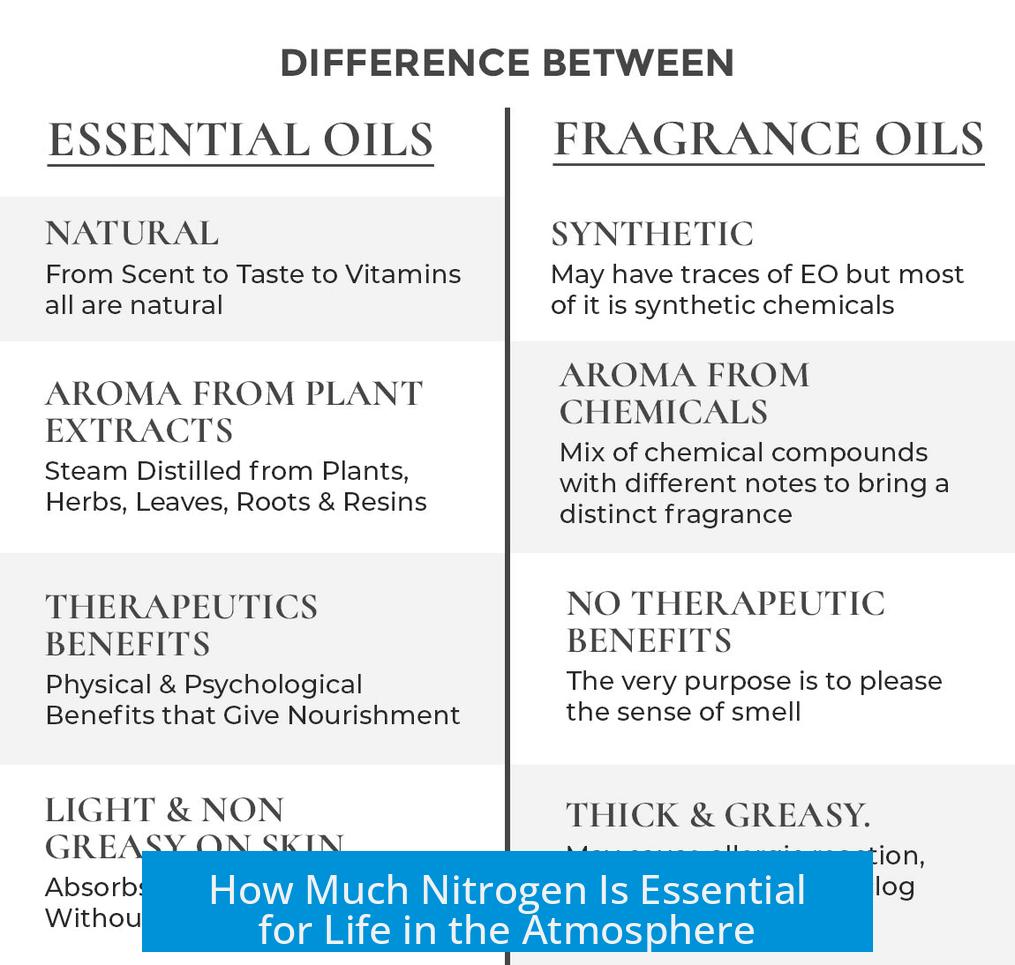How Much Nitrogen Is Needed in the Air for Life to Be Possible?
 The presence of nitrogen in the atmosphere at levels similar to Earth’s—around 78% by volume—is essential for supporting Earth-like life, mainly due to nitrogen’s role in biological processes. However, the exact minimal atmospheric nitrogen percentage required for life depends on multiple factors including total atmospheric pressure, nitrogen availability in soil, and the type of life considered.
The presence of nitrogen in the atmosphere at levels similar to Earth’s—around 78% by volume—is essential for supporting Earth-like life, mainly due to nitrogen’s role in biological processes. However, the exact minimal atmospheric nitrogen percentage required for life depends on multiple factors including total atmospheric pressure, nitrogen availability in soil, and the type of life considered.
Role of Atmospheric Nitrogen in Biological Systems
Atmospheric nitrogen (N2) is largely inert. It does not directly participate in metabolism for most animals or plants. Nonetheless, nitrogen is a critical element in amino acids, nucleic acids, and chlorophyll—all vital for life. Plants rely on nitrogen in chemically usable forms, such as nitrates and ammonium, primarily obtained from soil rather than directly from the air.

Some plants have evolved symbiotic relationships with nitrogen-fixing bacteria. These bacteria convert atmospheric N2 into bioavailable nitrogen compounds, supplying essential nutrients for growth. Without sufficient atmospheric nitrogen to sustain these bacteria, nitrogen cycling would be incomplete, impeding life.
Minimal Atmospheric Nitrogen Levels and Pressure Effects

Determining a precise minimal nitrogen percentage for viability is challenging. For example, would 8.4% nitrogen in the air suffice? There is no definitive answer, as biological fixation, gas partial pressures, and overall atmospheric pressure influence nitrogen availability. Total atmospheric pressure plays a vital role because it determines the partial pressure of nitrogen, which affects gas solubility and fixation rates.
At Earth’s surface, atmospheric pressure is about 1 atm. With nitrogen at 78%, its partial pressure is roughly 0.78 atm. If nitrogen levels dropped significantly, even with constant total pressure, partial pressure would decline, potentially limiting nitrogen fixation and biological uptake.

Comparisons and Alternative Life Possibilities
Plants thrive at very low CO2 levels—approximately 400 ppm—suggesting biological systems can adapt to low availability of certain gases. However, nitrogen is structurally central to life’s biochemistry on Earth and its abundance likely prevented evolution of more efficient extraction mechanisms from very low atmospheric concentrations.

Considering alien or non-Earth life forms introduces additional uncertainty. Nitrogen’s importance may be less for non-Earth-like life. Some hypothetical ecosystems might not require gaseous nitrogen or even oxygen, though such life remains speculative.
Key Takeaways

- Earth’s atmosphere contains about 78% nitrogen, creating favorable conditions for nitrogen fixation and life.
- Atmospheric nitrogen is mostly inert; plants rely on soil nitrogen, often supplied through bacterial fixation of N2.
- Minimal nitrogen percentages necessary for life depend on total atmospheric pressure and biological adaptation.
- Life under significantly lower atmospheric nitrogen might be constrained by reduced nitrogen fixation.
- Alien life could have alternative biochemistries, making nitrogen requirements different or irrelevant.
How Much Nitrogen Is Needed in the Air for Life to Be Possible?
How much nitrogen is essential in the air to support life? Well, it’s not about hitting a magic percentage for breathing animals but rather about nitrogen’s availability in forms that plants and microbes can use. That’s because atmospheric nitrogen (N2) is an unreactive, inert gas. It floats around making up roughly 78% of Earth’s atmosphere, but most life can’t use it directly. So, how much nitrogen *in the air* truly matters for life? Let’s unpack the story behind this mighty gas.
Why Is Nitrogen So Abundant Yet Mostly Untouchable?
Nitrogen hangs out in the atmosphere as a diatomic molecule (N2), which is incredibly stable. Imagine two nitrogen atoms holding hands in a very tight grip. This bond makes atmospheric nitrogen pretty inert. It doesn’t easily react or get absorbed in its gaseous form. Hence, most animals and plants don’t get their nitrogen needs straight from breathing air.
For example, animals rely on nitrogen-containing molecules like proteins and nucleic acids, but they obtain these compounds by eating plants or other animals. Plants, on the other hand, require nitrogen in reactive forms like nitrates or ammonium to build these essential molecules.
Plants and Nitrogen: The Soil Connection
Here’s a twist: plants NEED nitrogen, but atmospheric nitrogen in gas form isn’t their snack. Instead, they pull nitrogen compounds from soil, where bacteria and environmental processes convert the atmospheric nitrogen into usable forms.
Some plants go further and form a partnership, a symbiotic relationship with nitrogen-fixing bacteria. These bacteria can literally unlock atmospheric nitrogen, converting N2 into ammonia or related molecules plants can use. Legumes, like peas and beans, are famous hosts for these helpful bacteria.
Can Life Survive with Less Atmospheric Nitrogen?
Is 8.4% nitrogen in the air enough for life? That’s an intriguing question without a clear-cut answer. Because atmospheric nitrogen is inert and organisms don’t breathe it directly, survival depends not just on nitrogen’s percentage but on the total atmospheric pressure and the ability of microbes and plants to fix and cycle nitrogen.
The absolute pressure of gases matters far more than their relative percentages. For instance, if the total air pressure is 1 atmosphere, oxygen at 26% seems high and potentially harmful. Conversely, impacts of nitrogen being less than current would hinge on whether life forms can still generate enough reactive nitrogen through fixation and soil processes.
Looking Beyond Earth: Could Life Thrive with Less or No Nitrogen?
Curious about whether nitrogen must be as abundant as it is for all life? If you’re aiming for Earth-like life, nitrogen is indispensable. We can’t imagine proteins, DNA, or countless biochemicals without nitrogen atoms.
However, if we venture into alien life scenarios, nitrogen’s role might change. Could life evolve without oxygen or even without nitrogen as we know it? Theoretically, yes. Some hypotheses suggest alternative biochemistries. Yet, for our type of life here on Earth, nitrogen’s presence in the atmosphere helps maintain a stable nitrogen cycle crucial for ecosystems.
A Closer Look: Why Nitrogen Remains Mostly Unused in the Air
Considering plants thrive on minimal CO2—a mere 400 ppm—why doesn’t evolution push more plants or microbes to fix nitrogen directly from atmospheric N2? The answer could lie in nitrogen’s incredibly strong triple bond that demands significant energy to break. So, why bother evolving an energy-intensive process when soils already hold usable nitrogen thanks to bacteria?
This creates a balance where an overabundant supply of inert nitrogen doesn’t exert evolutionary pressure to “mine” it from air. Instead, life evolved mechanisms to utilize the soil reservoir enriched by microbial nitrogen fixation.
Practical Thoughts: What If Nitrogen Levels Shifted?
If atmospheric nitrogen dropped drastically, soil nitrogen availability would also drop over time, stressing plant communities and the entire food web.
Conversely, if nitrogen concentrations rose dramatically, we’d see little metabolic change because organisms aren’t using gaseous N2 directly. But changes in pressure or oxygen proportions could pose dangers or benefit other processes.
Summing It Up: The Real Question Is About Availability, Not Percentage
The key takeaway is that life doesn’t depend on atmospheric nitrogen percentage directly for breathing, but it relies on nitrogen’s presence in the environment and its transformation into reactive compounds.
The bulk of atmospheric nitrogen creates a stable, buffered environment allowing nitrogen fixation and recycling to feed plants. Without this massive nitrogen reservoir in the air, soil nitrogen levels and thus life as we know it would collapse.
Feeling Nutty About Nitrogen? Some Final Thoughts
- Atmospheric nitrogen is mostly a sleeper gas—it fills the air, provides balance, but sits quietly.
- Plants and microbes do the legwork—converting inert N2 into usable forms through fixation.
- Absolute pressure and ecological context matter—not just percentages.
- Alien life might rewrite these rules, but for Earth’s biosphere, our 78% nitrogen rulebook stays.
So, next time you breathe in the air, remember it’s not the nitrogen gas you’re feeding on directly. Instead, it’s the nitrogen cycle, powered by tiny, hard-working microbes and plant partnerships, quietly keeping life ticking. Without atmospheric nitrogen as a vast storehouse, this delicate dance could never start.
Want to dig deeper? Think about how humans influence nitrogen cycles through agriculture, fertilizers, and pollution. Could shifting nitrogen availability in soils change ecosystems? Definitely.
How much nitrogen must be in the air? Enough to maintain Earth’s pressure and supply the vast global nitrogen cycle. Nature’s way isn’t to breathe nitrogen but to transform it, feeding life from soil to sky.
How much nitrogen is required in the air for life similar to Earth’s?
There is no exact minimal percentage known. Earth’s atmosphere has about 78% nitrogen, which supports plants and animals. However, this large amount mainly acts as a buffer gas and doesn’t directly affect metabolism.
Can plants survive with less nitrogen in the air?
Plants do not absorb nitrogen gas directly. They rely on nitrogen compounds in the soil. Some plants partner with bacteria that convert atmospheric nitrogen into usable forms.
Why is the percentage of nitrogen in the air less important than total pressure?
The absolute pressure of gases matters more than their percentage. For example, oxygen can be harmful at high pressures even if its percentage is normal. The same principle applies to nitrogen’s role in the atmosphere.
Is atmospheric nitrogen essential for all types of life?
For Earth-like life, nitrogen is critical as a building block of amino acids and DNA. But other life forms, possibly alien, might not depend on nitrogen or even oxygen.
Could life exist with much lower nitrogen levels than on Earth?
It is uncertain. Lower nitrogen might work if life evolved efficient nitrogen fixation or used other elements. Current understanding is based on Earth, so we cannot rule out alternatives.





Leave a Comment